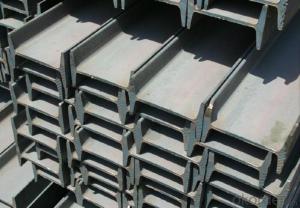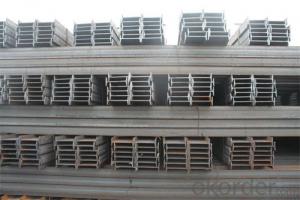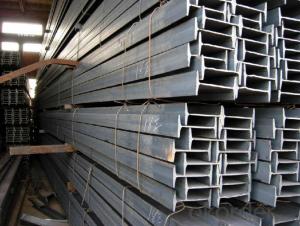Hot Rolled Steel of Q235B IPEAA80 for Construction Steel I-Beams
- Loading Port:
- Tianjin
- Payment Terms:
- TT or LC
- Min Order Qty:
- 25 m.t.
- Supply Capability:
- 100000 m.t./month
OKorder Service Pledge
OKorder Financial Service
You Might Also Like
OKorder is offering high quality Hot Rolled Steel I-Beams at great prices with worldwide shipping. Our supplier is a world-class manufacturer of steel, with our products utilized the world over. OKorder annually supplies products to European, North American and Asian markets. We provide quotations within 24 hours of receiving an inquiry and guarantee competitive prices.
Product Applications:
1. Supporting members, most commonly in the house raising industry to strengthen timber bears under houses. Transmission line towers, etc
2. Prefabricated structure
3. Medium scale bridges
4. It is widely used in various building structures and engineering structures such as roof beams, bridges, transmission towers, hoisting machinery and transport machinery, ships, industrial furnaces, reaction tower, container frame and warehouse etc.
Product Advantages:
OKorder's Steel I-Beams are durable, strong, and resist corrosion.
OKorder is offering high quality Hot Rolled Steel I-Beams at great prices with worldwide shipping. Our supplier is a world-class manufacturer of steel, with our products utilized the world over. OKorder annually supplies products to European, North American and Asian markets. We provide quotations within 24 hours of receiving an inquiry and guarantee competitive prices.
Product Applications:
1. Supporting members, most commonly in the house raising industry to strengthen timber bears under houses. Transmission line towers, etc
2. Prefabricated structure
3. Medium scale bridges
4. It is widely used in various building structures and engineering structures such as roof beams, bridges, transmission towers, hoisting machinery and transport machinery, ships, industrial furnaces, reaction tower, container frame and warehouse etc.
OKorder is offering high quality Hot Rolled Steel I-Beams at great prices with worldwide shipping. Our supplier is a world-class manufacturer of steel, with our products utilized the world over. OKorder annually supplies products to European, North American and Asian markets. We provide quotations within 24 hours of receiving an inquiry and guarantee competitive prices.
Product Applications:
1. Supporting members, most commonly in the house raising industry to strengthen timber bears under houses. Transmission line towers, etc
2. Prefabricated structure
3. Medium scale bridges
4. It is widely used in various building structures and engineering structures such as roof beams, bridges, transmission towers, hoisting machinery and transport machinery, ships, industrial furnaces, reaction tower, container frame and warehouse etc.
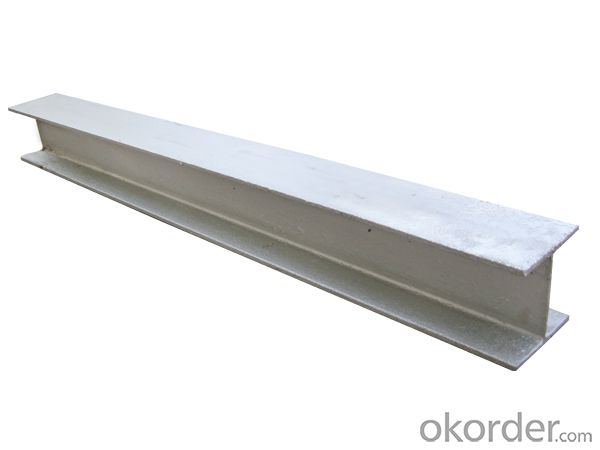
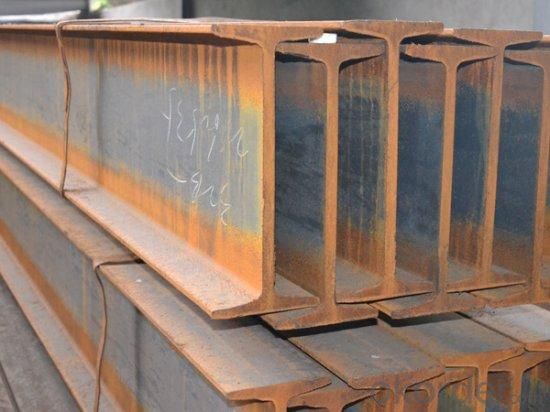
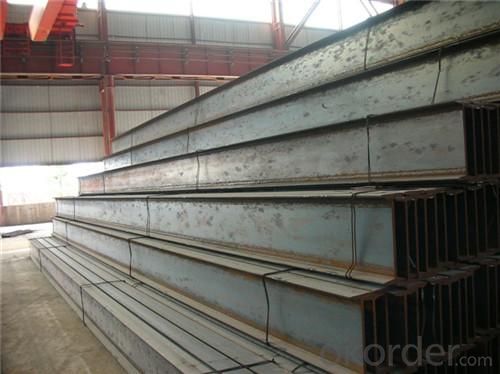
- Q:How do steel I-beams contribute to the overall sustainability of a building?
- Steel I-beams contribute to the overall sustainability of a building in several ways. Firstly, steel is a highly durable and long-lasting material, which means that I-beams made from steel can withstand heavy loads and provide structural support for many years. This durability reduces the need for frequent repairs or replacements, thus minimizing waste and conserving resources. Moreover, steel is a recyclable material, meaning that I-beams can be manufactured using recycled steel or can be recycled themselves at the end of their lifespan. This recycling process significantly reduces the environmental impact of steel production and helps to conserve natural resources. Additionally, the energy required to recycle steel is considerably less than that needed to produce it from scratch, further contributing to sustainability efforts. Furthermore, steel I-beams have a high strength-to-weight ratio, which means that they can support significant loads while using a relatively smaller amount of material compared to other alternatives. This efficiency in material usage reduces the overall carbon footprint of a building, as less steel is required for the construction of the structure. Another aspect of sustainability that steel I-beams contribute to is the ability to create open and flexible floor plans. The use of I-beams allows for longer spans and wider spaces, minimizing the need for additional columns or supports. This design flexibility allows for adaptable and customizable spaces, which can accommodate changing needs over time, ultimately extending the lifespan of a building and reducing the potential for demolition and waste. In conclusion, steel I-beams contribute to the overall sustainability of a building through their durability, recyclability, efficient material usage, and design flexibility. By choosing steel I-beams, architects and builders can help create environmentally-friendly structures that conserve resources, reduce waste, and have a longer lifespan.
- Q:What is the allowable stress for 40B I-beam?
- 40A I-beam allowable stress [Sigma]=145*1.3=188.5MPaI-beam is mainly divided into ordinary I-beam, light I-beam and H steel three.
- Q:How do steel I-beams perform in terms of deflection?
- The performance of Steel I-beams in terms of deflection is widely recognized. Their shape and material properties contribute to their exceptional resistance to bending and deflection when under a load. The I-beam's design, including the flanges and web, enables the load to be distributed evenly throughout the entire length of the beam, resulting in minimal deflection. Furthermore, the utilization of steel as the chosen material for I-beams offers high tensile strength, which further enhances their ability to resist deflection. In conclusion, steel I-beams are highly effective structural elements that play a crucial role in minimizing deflection and ensuring stability in diverse construction and engineering applications.
- Q:What are the common methods of installing steel I-beams in residential homes?
- There exist various common techniques for installing steel I-beams in residential homes. The direct bolted method is one of the most popular approaches. In this technique, the I-beam is positioned and aligned at the desired location, and subsequently secured by high-strength bolts that are drilled and fastened directly into the supporting structure. This method establishes a robust and reliable connection between the I-beam and the surrounding structure. Another widespread method is known as the steel plate method. With this approach, steel plates are welded to both ends of the I-beam, and these plates are then fastened or welded to the supporting structure. This technique permits a greater surface area for load distribution, resulting in increased strength and stability of the installation. A third technique is the employment of timber posts as support for the I-beam, commonly referred to as the timber post method. The I-beam is placed atop the timber posts and subsequently fastened or welded in place. This method is often utilized when installing the I-beam in an existing structure where space or accessibility is limited. Lastly, the concrete pier method involves the creation of concrete piers or footings to provide support for the I-beam. The I-beam is then placed on top of the piers and secured using bolts or welding. This method is frequently employed in areas with high load-bearing requirements or unsuitable soil conditions for other installation techniques. It is essential to acknowledge that the specific method employed for installing steel I-beams in residential homes may vary depending on structural requirements, local building codes, and the expertise of the overseeing contractor or engineer. It is always advisable to consult with a professional to determine the most suitable method for your specific project.
- Q:Can steel I-beams be used in hospitals?
- Yes, steel I-beams can be used in hospitals. Steel I-beams are commonly used in the construction industry for their strength and durability. In hospitals, steel I-beams can be used to provide structural support for the building, including supporting the floors, walls, and ceilings. They can also be used to create open spaces and large spans in the hospital design, allowing for flexible layouts and efficient use of space. Additionally, steel I-beams can be fire resistant, which is crucial in a hospital setting where safety is paramount. Overall, steel I-beams are a reliable and versatile choice for construction in hospitals.
- Q:How do steel I-beams perform in terms of thermal expansion?
- Steel I-beams have a relatively low coefficient of thermal expansion, making them perform well in terms of thermal expansion. This means that they expand and contract to a lesser extent compared to other materials when subjected to changes in temperature. The low coefficient of thermal expansion in steel I-beams is mainly attributed to the properties of the material itself, which exhibits minimal expansion or contraction when exposed to heat or cold. As a result, steel I-beams are less likely to warp or distort due to temperature fluctuations, making them highly reliable and structurally stable in various environmental conditions. This characteristic is particularly advantageous in construction and engineering projects where accurate measurements and stability are critical. Overall, steel I-beams are considered to have excellent thermal expansion properties, contributing to their widespread use in numerous industries.
- Q:How do steel I-beams handle extreme temperatures?
- Steel I-beams are known for their excellent strength and durability, making them a popular choice for structural support in various applications. When it comes to extreme temperatures, steel I-beams generally perform well due to their unique properties. Steel has a high melting point, typically around 1370 degrees Celsius (2500 degrees Fahrenheit). This means that in most cases, steel I-beams can withstand extreme temperatures without experiencing any significant structural damage. However, it's important to note that steel does expand and contract with temperature variations, which can affect its overall performance. In high-temperature environments, such as during a fire, steel I-beams may lose some of their strength due to thermal expansion. As the temperature rises, the steel expands, which can lead to distortions and buckling. However, steel's inherent strength allows it to retain its load-bearing capacity even when it is heated. On the other hand, in extremely cold temperatures, steel tends to become more brittle and prone to fracture. This is due to the reduction in ductility, which is the ability of a material to deform without breaking. In these conditions, steel I-beams may become more susceptible to cracking, especially if subjected to sudden impact or excessive loads. To mitigate the effects of extreme temperatures, engineers and designers often use various techniques. These can include implementing fire protection measures, such as fire-resistant coatings or insulation, to delay the onset of thermal expansion and maintain the structural integrity of the steel I-beams during a fire. Additionally, careful consideration is given to the material selection and design of the I-beams to ensure they can withstand anticipated temperature variations. In summary, steel I-beams are generally well-suited to handle extreme temperatures. They have a high melting point and retain their load-bearing capacity even when exposed to high temperatures. However, caution must be exercised in extreme cold temperatures to prevent potential brittleness and cracking. Proper design, material selection, and fire protection measures can help ensure the performance and longevity of steel I-beams in extreme temperature environments.
- Q:How do steel I-beams compare to composite beams in terms of cost and performance?
- Steel I-beams and composite beams have distinct differences in terms of cost and performance. In terms of cost, steel I-beams are generally more affordable compared to composite beams. Steel is a widely available and cost-effective material, making it a popular choice for structural applications. On the other hand, composite beams, which are typically made of a combination of materials such as steel, concrete, and fiber-reinforced polymers, can be more expensive due to the additional complexity and materials involved in their construction. In terms of performance, both steel I-beams and composite beams have their own advantages and disadvantages. Steel I-beams are known for their high strength and stiffness, making them suitable for heavy load-bearing applications. They have a proven track record of reliability and can withstand extreme conditions such as earthquakes and hurricanes. However, steel beams are susceptible to corrosion over time, which can affect their long-term durability and maintenance costs. On the other hand, composite beams offer a unique combination of properties that can enhance performance in certain applications. The use of different materials allows composite beams to optimize strength, stiffness, and weight, resulting in a higher strength-to-weight ratio compared to steel beams. This makes composite beams particularly advantageous in applications where weight reduction is crucial, such as aerospace or automotive industries. Additionally, composite beams have better resistance to corrosion and can provide improved fatigue and impact resistance compared to steel beams. In conclusion, steel I-beams are generally more cost-effective compared to composite beams. However, the choice between the two depends on specific project requirements and considerations. Steel I-beams are suitable for applications that require high strength and stiffness at a lower cost. On the other hand, composite beams offer unique performance advantages, such as high strength-to-weight ratio and corrosion resistance, making them ideal for applications that prioritize weight reduction and durability.
- Q:How do steel I-beams compare to other types of structural beams?
- Steel I-beams are widely regarded as one of the most versatile and efficient types of structural beams. Compared to other beams, such as wooden beams or concrete beams, steel I-beams offer several advantages. Firstly, steel I-beams have a high strength-to-weight ratio. This means that they can support heavy loads while remaining relatively lightweight. This makes them ideal for use in large-scale construction projects, such as skyscrapers or bridges, where the weight of the structure needs to be minimized without compromising on strength. Secondly, steel I-beams have excellent durability and structural integrity. Steel is a highly durable material that can withstand extreme weather conditions, including high winds, earthquakes, and heavy snow loads. It also has a long lifespan and requires minimal maintenance, making it a cost-effective choice in the long run. Another advantage of steel I-beams is their flexibility and adaptability. They can be easily fabricated and customized to suit specific design requirements. Steel can be cut, shaped, and welded into various lengths and shapes, allowing for greater design flexibility. This makes it possible to create complex structures and achieve unique architectural designs. Furthermore, steel I-beams offer superior fire resistance compared to other beams. Steel is non-combustible and does not contribute to the spread of fire. This makes it a safer choice for buildings and structures, especially in areas with strict fire safety regulations. Lastly, steel I-beams are environmentally friendly. Steel is a recyclable material, which means that it can be reused or repurposed at the end of its life cycle. Recycling steel helps to conserve natural resources and reduce carbon emissions associated with the production of new steel. In conclusion, steel I-beams have several advantages over other types of structural beams. They offer high strength-to-weight ratio, durability, flexibility, fire resistance, and environmental sustainability. These qualities make steel I-beams a popular choice in the construction industry for a wide range of applications.
- Q:How do steel I-beams compare to timber beams in terms of strength and durability?
- Steel I-beams are known for their exceptional strength and durability compared to timber beams. While timber beams have been used for centuries and offer certain advantages, such as their natural appearance and ease of installation, steel I-beams provide superior strength and longevity. In terms of strength, steel I-beams have a significantly higher load-carrying capacity compared to timber beams. Steel is inherently stronger than wood, allowing I-beams to support heavier loads without bending or breaking. This makes steel I-beams a preferred choice for large-scale construction projects, such as high-rise buildings, bridges, and industrial structures. Durability is another area where steel I-beams outperform timber beams. Steel is resistant to rot, decay, pests, and moisture, which are common challenges faced by timber beams. Steel I-beams have a longer lifespan and require minimal maintenance compared to timber, which may need regular inspections, treatments, and repairs to ensure structural integrity. Additionally, steel I-beams offer greater fire resistance compared to timber beams. Steel does not burn or contribute to the spread of fire, making it a safer choice in terms of structural stability and protecting occupants in case of a fire. Despite these advantages, there are instances where timber beams may be preferred. Timber beams are often utilized in residential construction or smaller scale projects where aesthetics and cost are important considerations. Timber beams can provide a more natural, warm, and appealing look, which may be desirable in certain architectural styles. In conclusion, steel I-beams surpass timber beams in terms of strength, durability, and fire resistance. They are the preferred choice for heavy load-bearing structures and projects where longevity and minimal maintenance are crucial factors. However, timber beams still have their place in smaller-scale construction projects, where aesthetics and cost take precedence over sheer strength and durability.
1. Manufacturer Overview |
|
|---|---|
| Location | |
| Year Established | |
| Annual Output Value | |
| Main Markets | |
| Company Certifications | |
2. Manufacturer Certificates |
|
|---|---|
| a) Certification Name | |
| Range | |
| Reference | |
| Validity Period | |
3. Manufacturer Capability |
|
|---|---|
| a)Trade Capacity | |
| Nearest Port | |
| Export Percentage | |
| No.of Employees in Trade Department | |
| Language Spoken: | |
| b)Factory Information | |
| Factory Size: | |
| No. of Production Lines | |
| Contract Manufacturing | |
| Product Price Range | |
Send your message to us
Hot Rolled Steel of Q235B IPEAA80 for Construction Steel I-Beams
- Loading Port:
- Tianjin
- Payment Terms:
- TT or LC
- Min Order Qty:
- 25 m.t.
- Supply Capability:
- 100000 m.t./month
OKorder Service Pledge
OKorder Financial Service
Similar products
New products
Hot products
Hot Searches
Related keywords

